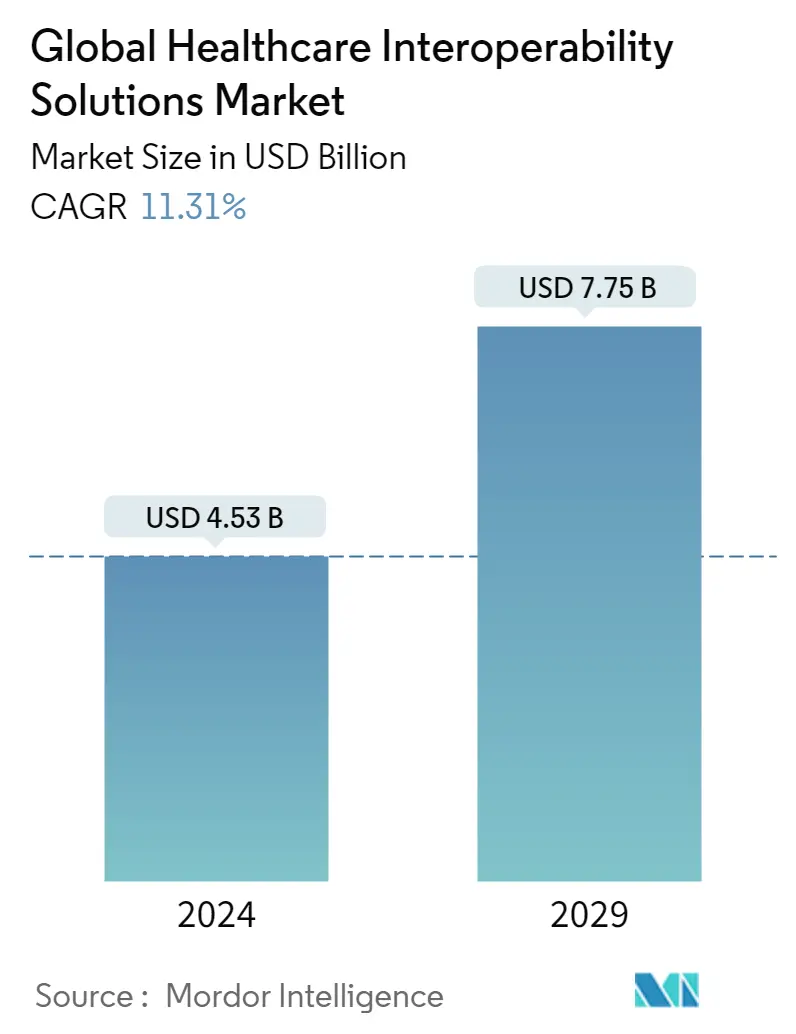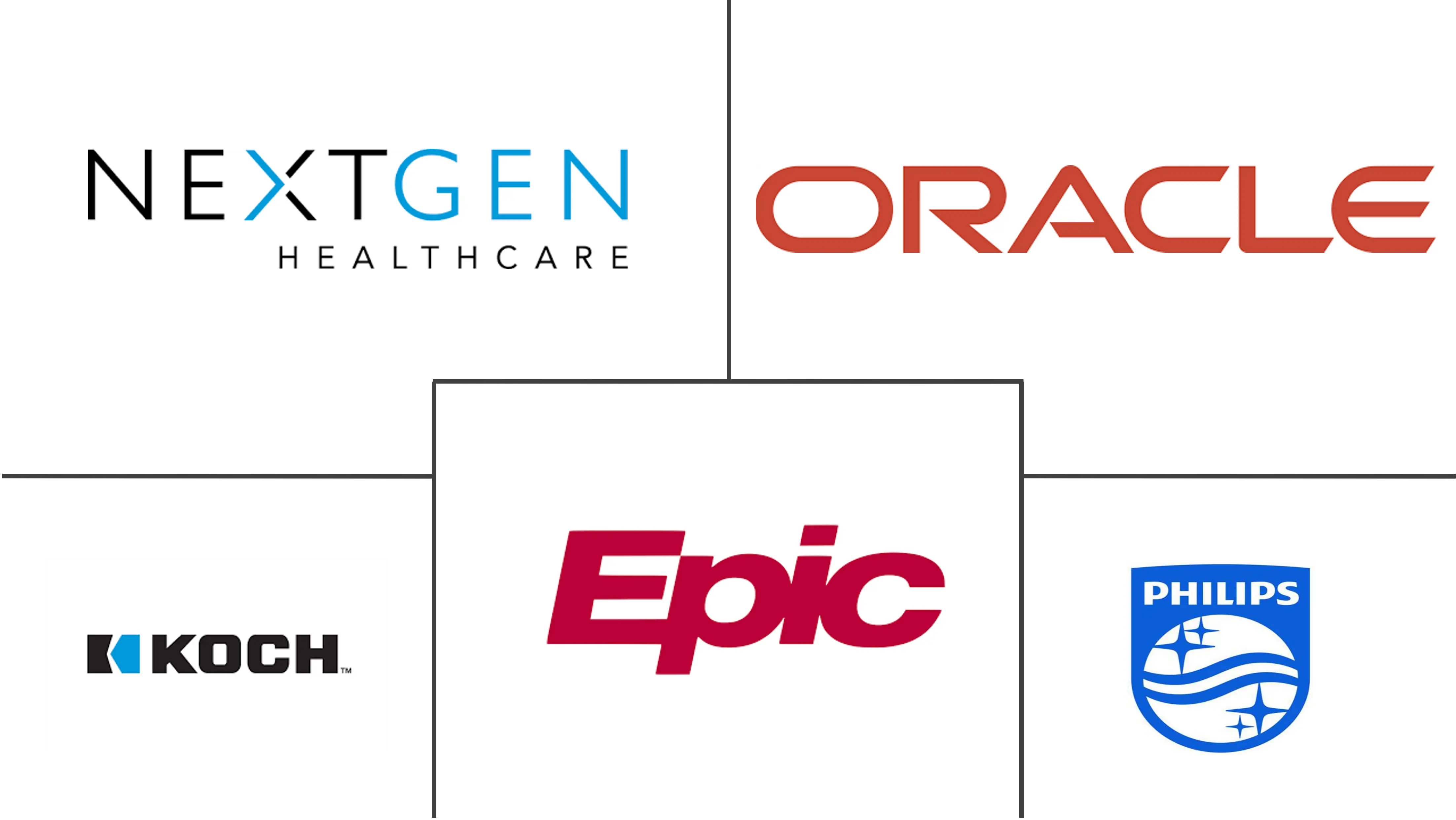Market Size of Global Healthcare Interoperability Solutions Industry

| Study Period | 2019 - 2029 |
| Market Size (2024) | USD 4.53 Billion |
| Market Size (2029) | USD 7.75 Billion |
| CAGR (2024 - 2029) | 11.31 % |
| Fastest Growing Market | Asia-Pacific |
| Largest Market | North America |
Major Players
*Disclaimer: Major Players sorted in no particular order |
Healthcare Interoperability Solutions Market Analysis
The Global Healthcare Interoperability Solutions Market size is estimated at USD 4.53 billion in 2024, and is expected to reach USD 7.75 billion by 2029, growing at a CAGR of 11.31% during the forecast period (2024-2029).
The COVID-19 pandemic had a significant impact on the world economy and healthcare infrastructure due to the sudden surge in COVID-19 patients. It significantly increased the demand for healthcare interoperability solutions because of the unforeseen influx of COVID-19 patients with different health conditions which disrupted the general functioning of any healthcare providing facility. For instance, according to an article published in February 2021, titled 'COVID-19 Highlights Need for Laboratory Data Sharing and Interoperability', the necessity for an interoperable healthcare system has become abundantly clear as a result of the SARS-CoV-2 pandemic, and in the United States, each state has its requirements for responding to the COVID-19, figures are inconsistent and depend on the location and information source. Further, as per the same source, the country's response to COVID-19 would be significantly improved by an interoperable healthcare system. For instance, a patient could contact their provider with symptoms, and the provider would have rapid access to the patient's complete medical information to treat any underlying issues. Hence it is anticipated that the COVID-19 pandemic is expected to have a significant impact on the healthcare interoperability solutions market.
The major factors that are expected to fuel growth in the healthcare interoperability solutions market include increasing adoption and investment in digital healthcare solutions by healthcare providers across the world and rising concerns over increasing healthcare costs. The healthcare interoperability solutions can help in reducing the increasing healthcare costs due to which they are expected to be adopted more widely over the forecast period and the market is expected to grow. For example, some of the major benefits of adopting healthcare interoperability solutions are an increase in healthcare efficiency, improvement in quality of care and patient experience, reduction the healthcare cost, and lightening physician burnout among other benefits. Hence, the investment in healthcare IT and interoperability solutions is expected to increase over the forecast period which is expected to fuel growth in the healthcare interoperability solutions market. For instance, in September 2020, the Office of the National Coordinator for Health Information Technology of the United States rewarded four organizations with funding of a total of USD 2.7 million under the Leading Edge Acceleration Projects in Health Information Technology program for the exploration of new opportunities for the adoption and use of health IT standards across the healthcare ecosystem.
Further, the increasing healthcare expenditure across the world is one of the major concerns for the governments, and to reduce that healthcare IT solutions are being adopted and deployed which is further expected to increase the adoption of healthcare interoperability solutions as they will play a crucial role in transferring of data from one place to another. For instance, according to the June 2022 report of the Federal Statistical Office (Destatis) of Germany, the country's healthcare expenditure is increasing year over year and in 2020 it stood at EUR 441 billion.
Moreover, the launch of new products in the area by the market players is further expected to boost the growth of the healthcare interoperability solutions market. For instance, in December 2021, CareCloud Inc. launched CareCloud Connector, a next-generation interface and data management engine for healthcare organizations. The solution offers ready-to-use integration that enhances data management and deployment speed while delivering improved interface control and visibility. Therefore, owing to the above-mentioned factors, the studied market is expected to grow over the forecast period. However, a shortage of skilled professionals in the area is expected to restrain the growth of the healthcare interoperability solutions market during the forecast period.
Healthcare Interoperability Solutions Industry Segmentation
As per the scope of this report, interoperability in healthcare facilitates timely and established access, integration, and application of electronic health data to enhance and optimize health outcomes for patients. The healthcare interoperability solutions market is segmented by deployment (cloud-based and on-premise), level (foundational, structural, and semantic), type (solutions and services), end user (healthcare providers, healthcare payers, and pharmacies), and geography (North America, Europe, Asia-Pacific, Middle East and Africa, and South America). The market report also covers the estimated market sizes and trends for 17 countries across major regions globally. The report offers the value in USD million for the above segments.
| By Deployment | |
| Cloud-based | |
| On-premise |
| By Level | |
| Foundational | |
| Structural | |
| Semantic |
| By Type | |||||
| |||||
| Services |
| By End User | |
| Healthcare Providers | |
| Healthcare Payers | |
| Pharmacies |
| Geography | ||||||||
| ||||||||
| ||||||||
| ||||||||
| ||||||||
|
Global Healthcare Interoperability Solutions Market Size Summary
The healthcare interoperability solutions market is poised for significant growth, driven by the increasing demand for integrated digital healthcare systems. The COVID-19 pandemic underscored the critical need for interoperability in healthcare, as it highlighted the challenges posed by disparate health information systems during the surge of patients with varying conditions. This demand is further fueled by the rising adoption of digital healthcare solutions and the need to manage escalating healthcare costs effectively. Interoperability solutions are expected to enhance healthcare efficiency, improve patient care quality, and reduce costs, making them increasingly attractive to healthcare providers worldwide. The market is also witnessing a surge in investments and innovations, with new products and services being launched to meet the evolving needs of the healthcare sector.
North America is anticipated to hold a significant share of the healthcare interoperability solutions market, with the United States leading due to its advanced digital healthcare infrastructure and substantial healthcare expenditure. The region's focus on digitalization and the presence of key market players contribute to its dominant position. The market is characterized by moderate competition, with several large and medium-sized players actively participating. Initiatives such as product launches, mergers, and collaborations are expected to further drive market growth. Despite the promising outlook, challenges such as a shortage of skilled professionals may hinder market expansion. Overall, the healthcare interoperability solutions market is set to experience robust growth, supported by technological advancements and increasing demand for seamless healthcare data exchange.
Global Healthcare Interoperability Solutions Market Size - Table of Contents
-
1. MARKET DYNAMICS
-
1.1 Market Overview
-
1.2 Market Drivers
-
1.2.1 Increasing Investment in IT Healthcare Solutions and Healthcare Interoperability
-
1.2.2 Rising Concerns Over Increasing Healthcare Costs
-
-
1.3 Market Restraints
-
1.3.1 Shortage of Skilled Healthcare IT Professionals
-
-
1.4 Porter's Five Forces Analysis
-
1.4.1 Threat of New Entrants
-
1.4.2 Bargaining Power of Buyers/Consumers
-
1.4.3 Bargaining Power of Suppliers
-
1.4.4 Threat of Substitute Products
-
1.4.5 Intensity of Competitive Rivalry
-
-
-
2. MARKET SEGMENTATION (Market Size by Value - in USD Million)
-
2.1 By Deployment
-
2.1.1 Cloud-based
-
2.1.2 On-premise
-
-
2.2 By Level
-
2.2.1 Foundational
-
2.2.2 Structural
-
2.2.3 Semantic
-
-
2.3 By Type
-
2.3.1 Solutions
-
2.3.1.1 EHR Interoperability
-
2.3.1.2 HIE Interoperability
-
2.3.1.3 Other Types
-
-
2.3.2 Services
-
-
2.4 By End User
-
2.4.1 Healthcare Providers
-
2.4.2 Healthcare Payers
-
2.4.3 Pharmacies
-
-
2.5 Geography
-
2.5.1 North America
-
2.5.1.1 United States
-
2.5.1.2 Canada
-
2.5.1.3 Mexico
-
-
2.5.2 Europe
-
2.5.2.1 Germany
-
2.5.2.2 United Kingdom
-
2.5.2.3 France
-
2.5.2.4 Italy
-
2.5.2.5 Spain
-
2.5.2.6 Rest of Europe
-
-
2.5.3 Asia-Pacific
-
2.5.3.1 China
-
2.5.3.2 Japan
-
2.5.3.3 India
-
2.5.3.4 Australia
-
2.5.3.5 South Korea
-
2.5.3.6 Rest of Asia-Pacific
-
-
2.5.4 Middle East and Africa
-
2.5.4.1 GCC
-
2.5.4.2 South Africa
-
2.5.4.3 Rest of Middle East and Africa
-
-
2.5.5 South America
-
2.5.5.1 Brazil
-
2.5.5.2 Argentina
-
2.5.5.3 Rest of South America
-
-
-
Global Healthcare Interoperability Solutions Market Size FAQs
How big is the Global Healthcare Interoperability Solutions Market?
The Global Healthcare Interoperability Solutions Market size is expected to reach USD 4.53 billion in 2024 and grow at a CAGR of 11.31% to reach USD 7.75 billion by 2029.
What is the current Global Healthcare Interoperability Solutions Market size?
In 2024, the Global Healthcare Interoperability Solutions Market size is expected to reach USD 4.53 billion.

